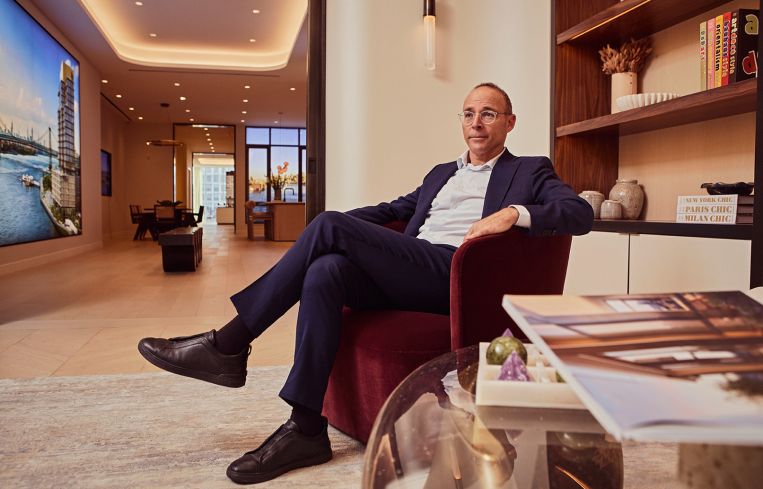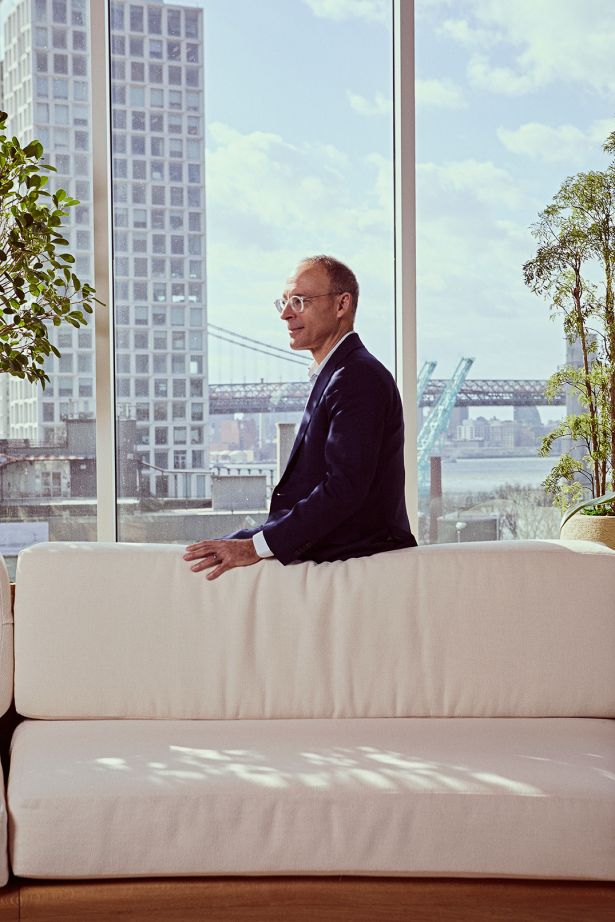Developer Miki Naftali On the Brooklyn Waterfront, Miami’s Appeal and More
‘Let’s be real for a second — no one is going to build anything if he or she knows that they're going to lose money.’
By Amanda Schiavo February 5, 2025 6:00 am
reprints
They say a wise man builds a home upon rock. For Miki Naftali, CEO of the development and investment firm Naftali Group, the Brooklyn waterfront represents a steadfast and enduring foundation.
For over 35 years, Naftali has been developing commercial projects across the United States, including in New York and South Florida, and also internationally in Singapore. In each development, his focus has been to find the right properties in the right neighborhoods.
With the continuing shift of residents to Brooklyn from Manhattan — the former gained more than 16,000 residents from the latter in 2022 alone, according to PropertyShark research — Naftali has embarked on an ambitious luxury residential development in the popular Brooklyn neighborhood of Williamsburg.
Williamsburg Wharf will consist of five 22-story towers totaling 850 apartments and condos along 525 feet fronting the East River. There will be commercial and retail aspects to the complex, too. The penthouse of One Williamsburg Wharf has already sold for around $7 million, which is way more than is standard for Brooklyn.
Commercial Observer recently caught up with Naftali (pronounced naf-TAL-ee) for a one-on-one chat about Williamsburg Wharf, Brooklyn’s residential real estate market, what else Naftali Group has been up to around New York City and other locations, as well as the challenges and opportunities in developing affordable housing.
This interview has been edited for length and clarity.
Commercial Observer: What makes Brooklyn — specifically Williamsburg — an attractive market for luxury residential real estate?
Miki Naftali: Well, residential is the best sector of real estate, because people need to live somewhere. At the end of the day, either you’re going to rent or you’re going to buy, depending on what you can or cannot afford. People need to live somewhere, and the population is growing. I think it’s very clear how — except within a year or two during COVID-19 — overall that the trend is to move from the suburbs to more urban types of living.
Brooklyn became a brand name years ago, and, when you zero in within Brooklyn, Williamsburg is a brand name. And that stretch of Williamsburg along the waterfront is just amazing.
I give a lot of credit to the City of New York and previous administrations. They looked at the waterfront and they created — anywhere from Williamsburg up to Greenpoint — a really fantastic area. What is so unique here is that the building sits on the waterfront. It’s so special.
When people go on vacation they like to go to resorts, and so many people love to be on the water. They like when there is a pool deck overlooking the water. When we looked at the Williamsburg waterfront, we said, “This is amazing. We can create an urban resort that is actually offering a space for residents that they really don’t need to leave New York City.” I couldn’t do it in any other place in the city.
Two Trees Management is also developing on the Williamsburg waterfront at Domino Park. Talk to us about the competition in the area and what sets Naftali Group apart.
What Two Trees has done in the last decade in Brooklyn is amazing. They are really capable, and develop beautiful buildings. Traditionally and historically they develop Class A rental buildings, and they really are not a condo type of developer. Their rental buildings are well received and they are commanding really high rents.
Competition is good, especially when your competition is very capable and they can create a good product, because it creates a high-end product in a neighborhood, so you are not the only one creating something high end. Domino Park is amazing, and it’s a great location.
Our condo product is just a little bit of a better product because we design for the condominium buyer, not the rental customer.
There is enough demand in Williamsburg for both of us. Ten or 15 years ago, the competition was about delivering apartments that were less expensive than in Manhattan. So the quality of the design, the quality of the product, wasn’t as good because as a developer you couldn’t spend as much money as in the city. It’s not the same game today.
What is your goal for your development on the Williamsburg waterfront?
We’re actually building a small neighborhood, because when it’s all said and done we’ll have five buildings. The first phase, which we are completing this year, will have three buildings. One of them is the condominium building with 89 condominium units, and then the other two buildings are Class A, top-of-the-line rental buildings.
We have over 500 rental units, and each building has its own set of amenities, including coworking spaces. That is about knowing your neighborhood, knowing your demographic, and knowing who is buying and who is renting.
When you really zoom into Brooklyn and Williamsburg, the demographic is between people in their mid to late 20s and 40s. And, even if these people are going into an office, it usually isn’t five days a week. They spend a lot of time in their apartments, and we listen to what they need. At the end of the day, they need to make some money in order to pay the cost of living. Most of our buyers and future renters, they work from home, especially in creative types of jobs, and you need to be in a space where there are creative vibes.
So, in each building we have coworking spaces, we have privacy spaces for creating content — podcast rooms and private meeting rooms that you can book. There are communal spaces and tables to sit and work and meet new people.
Wherever we design and build a project, we listen to the demand in the market. We try to really understand what our customers are looking for, what they do, and what they want. It is not necessarily about the architect or the interior designer, or even what Miki wants. It’s about what they want, what they need, what will make their life really great in one of our buildings.
The apartments we created are beautiful, nice and very comfortable, but more than that it is about community, which is very important to the demographic in Williamsburg and Brooklyn.

You mentioned the two Class A rental buildings. Will any of those units be designated as affordable housing?
Yes, and the buildings that we are completing this year — we’ll be able to start moving in renters this summer — were built based on the previous affordable New York program 421a. So, yes, we do have affordable housing, and I think about 25 percent of the buildings will be affordable, and next month we’ll be starting the lottery. So we’ll have both affordable and free-market housing.
New York City’s housing crisis is no secret, and both the state and local governments are doing what they can to incentivize affordable housing development. Do you think developers who are coming into a situation like this have a responsibility to make their units affordable?
A responsibility? Yes, but let’s be real for a second: No one is going to build anything if he or she knows that they’re going to lose money. It doesn’t make sense. The only entity that can build something and lose money is the government. There is no private investor in any type of business, not just real estate, that is going to do something if he or she knows that they’re going to lose money.
The problem is the cost of land, the cost of construction, the cost of insurance, and interest, the cost to carry those buildings during the construction, and, on top of all of that, the cost of the real estate taxes. If we want to be serious about solving the affordable issue — and, by the way, I don’t think the government should build because they are not efficient enough — the only way to solve the affordable issue is to make sure the private developers have a program that they can build something and make a reasonable profit.
I would be happy to do it, but how? You need to give incentives. For a politician to take a position and say, “Oh, developers make so much money, they can build affordable housing,” is not a serious approach. We take so many risks during development. We borrow so much money in a high interest rate environment that we take a lot of risk. Some of us, if we are successful, we make money. There are other developers that are defaulting on loans, and they are not successful for many different reasons.
So, what can we do? Find a way to lower the cost of land. How do you lower the cost of land? Well, if the state or federal government owns the land and they are really serious about creating affordability, they should sell at a very low price — with the condition that the buyer builds or converts it into affordable housing.
Another option is to rezone an industrial area so we can come in and create a residential neighborhood. But the price will be based on the cost prior to the rezoning, so basically your price per unit is low enough so you can build affordable housing. The other option is to give really, really substantial, deep tax incentives. The city, the state, the federal government cannot control the cost of construction.
If we all want to be serious about solving the affordable issue, at the end of the day it’s about the dollars and cents, and to make sure that it makes financial sense for developers to do it.
Outside of Brooklyn, Naftali Group is also developing in Manhattan and Florida. Tell us about those projects.
In addition to our amazing Williamsburg project, we’re building a 50-story, beautiful building on the corner of 77th Street and Second Avenue. It’s a sister building to 200 East 83rd Street, which is a 50-story building that we completed a couple of years ago. Both buildings are designed by Bob [Robert A.M.] Stern — he’s a great architect. Then we have The Henry on the Upper West Side, another beautiful building that is under construction right now. Those three projects are performing very well, and the three of them are close to 50 percent sold between September and now.
I think what we are seeing here is a strong demand for quality. It took me many years to get to a point where brokers and buyers realized that we not only design but deliver really nice, good quality. And there is a real demand for quality.
What we design and deliver on the Upper West Side is different than what we design and deliver in Brooklyn. Every neighborhood in New York is different.
Moving to South Florida, you cannot go into a different geographic area and assume I know what to do. The reason we decided to go to South Florida is twofold. No. 1, we always want to develop something in a high-demand market. We are good, but we are not good enough to create demand. I can’t go to a city where there is no demand and say, “Oh, we are so good. We can create a demand.” Once you have the demand, we can cater to the demand for the best product. We can compete head to head and deliver a really, really good product.
Miami, to some extent, it’s an interesting story like Williamsburg. That market also moved in the last 10 years. The demand for quality changed. Restaurants in Miami 10 years ago were OK, now there are some amazing restaurants in Miami. And, again, the demographic has changed. People are there, and they’re willing to spend a lot of money, but they want the quality — they want the quality in restaurants, they want the quality in retail, and they want the quality in housing.
In Fort Lauderdale, we wanted to deliver five-star service. We worked with the Viceroy Hotel Group, and we created two residential buildings branded by Viceroy Residences.
There is no competition between New York and Miami, or New York and Fort Lauderdale. Both markets are doing well. There is just a good demand, and it is all about choices.
Amanda Schiavo can be reached at aschiavo@commercialobserver.com.



